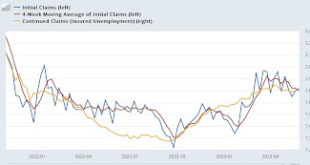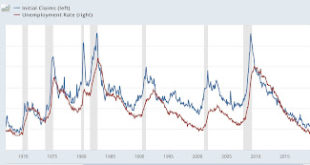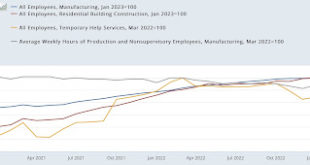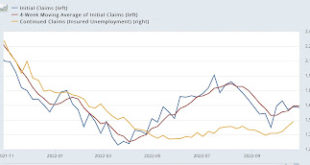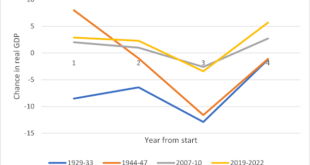New and improved initial claims! Now including comparison to Sahm Rule – by New Deal democrat I’m making an important addition to my weekly blurb on jobless claims this week: I’m showing how it compares with and leads the Sahm Rule. Just in case you’re not familiar with the Sahm Rule, it is a rule of thumb started by economist Claudia Sahm, stating that the economy is in a recession when the 3 month average of the unemployment rate rises...
Read More »March employment report 2: unemployment recession indicators
Scenes from the March employment report 2: unemployment recession indicators – by New Deal democrat A reminder: I may be offline for the next couple of days. In the meantime, yesterday I looked at the 5 leading indicators contained in the employment report, and summarized how they either signal recession now or within the next 3 to 6 months. Today I want to focus on unemployment and underemployment. Economist Gloria Sahm’s Rule, namely...
Read More »Scenes from the March employment report 1: Leading sector indicators
Scenes from the March employment report 1: leading sector indicators – by New Deal democrat There’s no significant economic news this week until Wednesday’s CPI report, and as a side note, I might be offline for a day or two later this week. In the meantime, today and tomorrow let’s take a look at some of the important information from last Friday’s employment report. Today, I’m taking a look at the leading employment sectors and several...
Read More »Jobless claims: steady as she goes
Jobless claims: steady as she goes by New Deal democrat [ Special programming note: yesterday’s Fed action, and more important the statements made afterward, merit special attention. I will put up a special post on that later today.] Initial jobless claims remained at their recent low level, down -1,000 from one week ago to 217,000. The 4 week average declined -500 to 218,750. Continuing claims, which lag slightly, rose 47,500 to a 7 month...
Read More »August JOLTS report: the game of reverse musical chairs in the jobs market is ending
August JOLTS report: the game of reverse musical chairs in the jobs market is ending – by New Deal democrat Since early this year I’ve been making the point that, because of the pandemic, there have been several million fewer persons looking for work, leaving a huge number of unfilled job vacancies, particularly in the face of a roughly 10% higher jump in demand. This has given employees the upper hand, as there are almost always higher...
Read More »Resurrecting the metric: initial claims lead the unemployment rate
Resurrecting the metric: initial claims lead the unemployment rate; no recession signal so far Initial jobless claims declined -2,000 to 229,000 last week, vs. the 50+ year low of 166,000 set in March. The 4 week average rose from 4,500 to 223,500, compared with the all-time low of 170,500 eleven weeks ago. Continuing claims rose 5,000 to 1,315,000, which is 9,000 above their 50 year low of 3 weeks ago: Initial claims have been in an uptrend...
Read More »The Great Unemployment Fudge
In the U.S., we are told, the post-World War II period was a golden age of full employment. High wartime government spending had brought to an end the double-digit unemployment and misery of the Depression, and as war gave way to peace, unemployment settled at a non-inflationary level of 3-5%. It's known as the post-war "economic miracle".But it's a myth. There was never full employment. The low unemployment of the post-war years is a massive statistical fudge. In fact, over five million...
Read More »the recession’s likely long-term impact on homelessness
I’ve just written a report for Employment and Social Development Canada on the current recession’s likely long-term impact on homelessness in Canada. An overview of the report can be found here. Nick Falvo is a Calgary-based research consultant with a PhD in Public Policy. He has academic affiliation at both Carleton University and Case Western Reserve University, and is Section Editor of the Canadian Review of Social Policy/Revue canadienne de politique sociale. You can...
Read More »Lifting singles out of poverty in canada
I’ve written a report for the Institute for Research on Public Policy about social assistance—specifically, about social assistance for employable single adults without dependants. A ‘top 10’ overview of the report can be found here. Nick Falvo is a Calgary-based research consultant with a PhD in Public Policy. He has academic affiliation at both Carleton University and Case Western Reserve University, and is Section Editor of the Canadian Review of Social...
Read More »Social assistance: Do higher benefit levels lead to higher caseloads?
As part of my PhD thesis, I did some statistical analysis in which I asked the question: “Do higher social assistance benefit levels lead to higher caseloads?” I have recently updated the data and had it published in a journal. Here’s a short summary of the journal article’s main findings. Nick Falvo is a Calgary-based research consultant with a PhD in Public Policy. He has academic affiliation at both Carleton University and Case Western Reserve University, and is...
Read More » Heterodox
Heterodox

